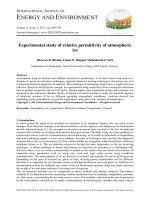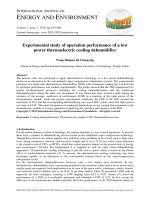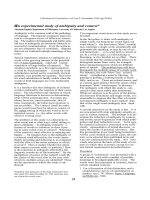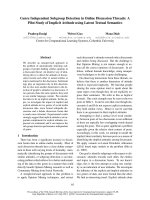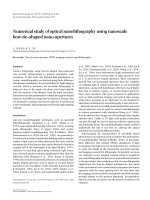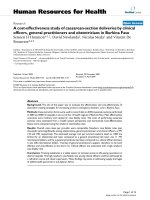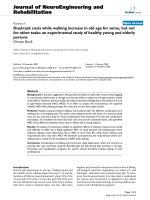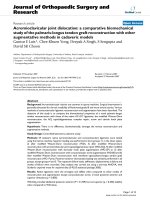Experimental study of passive cooling of building facade using phase change materials to increase thermal comfort in buildings in hot humid areas
Bạn đang xem bản rút gọn của tài liệu. Xem và tải ngay bản đầy đủ của tài liệu tại đây (363.24 KB, 10 trang )
I
NTERNATIONAL
J
OURNAL OF
E
NERGY AND
E
NVIRONMENT
Volume 3, Issue 5, 2012 pp.739-748
Journal homepage: www.IJEE.IEEFoundation.org
ISSN 2076-2895 (Print), ISSN 2076-2909 (Online) ©2012 International Energy & Environment Foundation. All rights reserved.
Experimental study of passive cooling of building facade
using phase change materials to increase thermal comfort in
buildings in hot humid areas
A. A. Madhumathi
1
,
B. M.C. Sundarraja
2
1
Department of Architecture, Thiagarajar College of Engineering, Madurai-15, Tamilnadu, India.
2
Department of Civil Engineering, Thiagarajar College of Engineering, Madurai-15, Tamilnadu, India.
Abstract
Storage of cooler night temperatures using Phase Change Material (PCM) energy storage technique, for
cooling of ambient air during hot day times can be an alternate of current cooling techniques in building
sector. This work presents the results of an experimental set-up to test energy saving potential of phase
change materials with typical construction materials in building facade in Hot-Humid Climatic Regions
in real conditions. The
main objective of this research is to demonstrate experimentally that
it is possible
to improve the thermal comfort and reduce
the energy consumption of a building without substantial
increase in
the weight of the construction materials with the inclusion of
PCM. This research was
conducted to study and evaluate the performance of the existing materials integrated with Organic PCM
Polyethylene glycol (PEG) E600. This research suggested that the heat gain is significantly reduced
when the PCM is incorporated into the brick (conventional building material).
Copyright © 2012 International Energy and Environment Foundation - All rights reserved.
Keywords: Hot and humid climates; Latent heat storage; Phase change material; Sustainable design;
Technology thermal comfort.
1. Introduction
The worldwide economical and technological development requires higher energy demands and higher
comfort expectations (heating and cooling systems). However, energy sources are limited and related to
harmful gases, which are responsible for climate changes, global warming and environmental problems.
Scientists all over the world are in search of new and renewable energy sources to reduce the CO
2
emissions from the combustion of fossil fuels, particularly in areas where low temperature applications
are involved. In an attempt to reduce CO
2
emissions (as well as to reduce the cost associated with the
cooling and heating of buildings), various studies based on the use of energy storage materials, which
can absorb thermal energy at one time(day time) and release it at later time(night time), are engaged all
over the World.
The concept of storing heat within the building walls has been around since 1881. The building’s mass
plays an important part in determining the temperature. A heavy building is able to smooth out
temperature peaks by virtue of its mass. The use of thermal mass in shelter dates back to the dawn of
humans, and until recently has been the prevailing strategy for building climate control in hot regions.
Today there is a shift away from traditional construction materials and block building techniques towards
light weight building materials and prefabricated building elements. However, a move to lightweight
International Journal of Energy and Environment (IJEE), Volume 3, Issue 5, 2012, pp.739-748
ISSN 2076-2895 (Print), ISSN 2076-2909 (Online) ©2012 International Energy & Environment Foundation. All rights reserved.
740
construction raises concerns over internal comfort conditions due to lack of thermal storage properties,
resulting in rapid swings of internal temperature.
Optimized selection of building materials for making the external envelop also plays an important role in
achieving thermal comfort in buildings, where thermal comfort is achieved through passive –cooling,
strategies. Many materials and systems currently on the market are designed to keep interiors warm by
virtue of their insulating properties. PCMs are proved to be very effective in light weight buildings, since
they increase their thermal mass.
Phase Change Materials (PCMs) are proposed as a solution to reduce energy demands from buildings by
the addition of PCMs to construction materials as concrete, gypsum or plasterboard panels [1, 2]. Recent
research has looked at the incorporation of organic PCMs into porous building materials, creating
functional and effective building elements which can affect significant energy savings.
The thermal energy storage property of PCMs is based on its capability of latent heat storage, because
large amounts of energy can be stored in a small volume of PCM. Therefore, the material containing
PCMs can absorb and release heat more effectively than conventional building materials [3]. Similarly,
the energy needed to produce the PCMs would only be a fraction of the energy needed to produce blocks,
bricks or concrete with the same heat storage capacity [4]. Its high thermal inertia does not require the
use of thick layers, resulting as a very low invasive technology. Thermal inertia is the degree of slowness
with which the temperature of a body approaches that of its surroundings and which is dependent upon
its absorptivity, its specific heat, its thermal conductivity, its dimensions, and other factors
The utilization of PCM in active and passive solar buildings has been subject to considerable interest
since the first reported application in the 1940s [5]. PCMs store latent heat as the ambient temperature
rises up to the melting point (PCM changes from solid to liquid state) [6]. As the temperature cools
down, the PCM return to solid phase and the latent heat is released. This absorption and release of heat
takes place at a constant temperature, which is ideal to smooth temperature fluctuations. The thermal
improvements in a building due to the inclusion of PCMs depend on the climate, design and orientation
of the construction, but also to the amount and type of PCM [7].
PCM materials can contribute to the energy efficiency of buildings by reducing the peaks in the daily
temperature cycles. It may be possible that mechanical air conditioning is not needed at all; as a
minimum, the energy consumption for air conditioning can be reduced. And this is how it works: as part
of normal overnight ventilation, the warm air in the building is replaced by cold night-time air, which
also reduces the temperature of the building’s solid structures over the course of the night. PCM can
increase the heat capacity of the building, meaning that additional ‘coldness’ can be stored in the
building’s structures. PCM can be integrated into walls, ceilings or facade elements, for example.
2. Comfort temperatures and climatic data for Madurai region
A hot-humid climate is defined as a “region that receives more than 20 inches of annual precipitation”
and either has 3,000 or more hours of 67˚F temperature or 1,500 or more hours of 73 ˚F temperature
during the warmest six months of the year. In this type of climate, the main function of the buildings is to
simply moderate the daytime heating effects of the external air [8].
The air temperature and relative humidity are the important factors in determining the comfort level in
the hot and humid region. The typical climate of the hot and humid region is the high air temperature at
an average of 28˚ Celsius with an average of 80% of relative humidity. These factors have become the
biggest challenge for the architects in designing a passive cooling building. The hot air and high relative
humidity have become very problematic in designing naturally ventilated buildings.
The experimental study area Madurai comes under hot humid climate with maximum average
temperature 35.38˚c and minimum average temperature 24.82˚c (for year 2009-2010) and average
relative humidity 60 %( for year 2009-2010). Since it is like summer all year around, cooling is the main
issue regarding buildings in Madurai. Most of the buildings are built with Reinforced Concrete Slabs
(RCC) as roofing system and Clay tile roofs for a smaller percentage. Moreover, most of these buildings
have no insulation material installed As a result, these buildings act like a sauna, where most of the
building facades are exposed to excessive solar radiations that absorb heat throughout the day. The heat
is then conducted to the inner spaces, thereby creating thermal discomfort for the building occupants.
PCM has never been tested in a hot humid climate like Madurai in India, and thus the potential benefits
remain uncertain, especially for the residential sector. This study investigates the potential of using PCM
for thermal heat storage in building facades in hot humid climates. This integration will likely cause an
International Journal of Energy and Environment (IJEE), Volume 3, Issue 5, 2012, pp.739-748
ISSN 2076-2895 (Print), ISSN 2076-2909 (Online) ©2012 International Energy & Environment Foundation. All rights reserved.
741
increase in heat transfer that will increase heat storage capacity and reduce internal temperature
fluctuations compared with other materials that have been used until today.
Average monthly daily hourly temperature data for a year of June 2009 to May 2010 of Madurai is
obtained from Meteorological department and is shown in Table 1 which will be used for further analysis
and basis for finding the comfort temperatures. The average monthly maximum and minimum
temperatures are obtained is used to calculate the mean temperatures. Mean temperatures are then used to
calculate the comfort temperatures for each month. Adaptive comfort temperature standards allow
occupants to restore comfort when they feel discomfort [9].
Table 1. Temperature data: -Madurai, Tamilnadu, India 2009-10 (in Celsius)
Maximum Minimum Humidity in %
Year Month
Highest Mean Lowest Mean 8.30 Hours 17.30 Hours
June 39.6 37.9 24.6 26.2 58 44
July 39.8 37.7 25.2 26.7 53 42
August 39.6 37.0 23.4 25.8 62 51
September 39.6 36.6 23.8 25.8 66 52
October 37.8 35.9 22.8 25.0 65 46
November 33.6 30.8 20.6 23.6 81 75
2009
December 31.8 29.8 20.9 22.7 78 67
January 33.0 31.3 19.8 21.9 75 51
February 37.0 33.5 19.7 22.1 76 39
March 38.8 37.2 19.4 24.1 70 32
April 40.2 38.7 24.4 26.8 66 42
2010
May 41.4 38.2 23.2 27.2 77 64
Source: India Meteorological Department, Chennai-6
Many of the International Standards produced are found to be inadequate for describing the comfort
condition in the tropical climate. The majority of the field studies conducted discovered that the
international set up is either overestimating or underestimating the comfort condition in this climate [10].
This is partly due to the derivation of the standards that are mainly based on the studies conducted in the
moderate environmental condition.
One of the international standards frequently used for indoor climate condition is ISO7730 based on
Fanger’s predicted mean vote (PMV/PPD) equation. The equation of the formula is applied to derive a
numerical value depicting the comfort conditions based on the ASHRAE scale. The air temperature of
30˚ Celsius is considered normal for this climate and the air movement of more than 1 m/s is desirable to
relieve the heat. The outside climate plays a very influential role in thermal comfort perception for a free-
running building. The study by Humphreys and Nicol [11] discovered that the comfort temperatures are
linearly related to the mean outdoor temperature.
Comfort temperatures are defined using equation (1)
9.12534.0 += ToTc
(1)
where
Tc
is comfort temperature and
To
is average monthly mean outdoor temperature.
In equation (1) ‘
To
’, mean temperature of any month and is defined by
()
2/minmax TTTo +=
(2)
In equation (2) Tmax and Tmin are the monthly average maximum and minimum temperatures which are
obtained from Table 1.
Standard that is frequently referred in evaluating comfort condition in Hot Humid Regions is ASHRAE
Std 55. A revised version of ASHRAE Std 55, known as Adaptive Comfort Standard (ACS), has been
produced to be applied for naturally ventilated buildings since the original version is found to be
irrelevant for naturally ventilated buildings. In the revised version, allowance for the warmer indoor
International Journal of Energy and Environment (IJEE), Volume 3, Issue 5, 2012, pp.739-748
ISSN 2076-2895 (Print), ISSN 2076-2909 (Online) ©2012 International Energy & Environment Foundation. All rights reserved.
742
temperature is given and to be applied during summer time for the naturally ventilated (NV) buildings. A
wider range of indoor temperature was given based on the findings from the occupants in the NV
buildings. The wider range is mostly influenced by the outdoor climate patterns which led to the
derivation of the optimum comfort temperature, Tcomf, that is based on the mean outdoor dry bulb
temperature, Ta,out:
8.17,31.0 += outTaTcomf
(3)
Tcomf, aiming to discover the temperature or combination of thermal variables (temperature, humidity
and air velocity) which most of the people consider ‘neutral’ or ‘comfortable’.
Ta,out is calculated according to equation (2).
Humphreys and Nicol [11] had also suggested that in evaluating thermal comfort using adaptive
principle, there are three main contextual variables that need to be considered which are the climate,
building and time.
Comfort temperatures according to equation (3) are tabulated in Table 2 for all the summer months in
Madurai –India.
Table 2. Comfort temperature for Madurai –India
Temp.
(˚C)
June July Aug Sept Oct Nov Dec Jan Feb Mar Apr May
Maximum
(ambient)
37.9 37.7 37.0 36.6 35.9 30.8 29.8 31.3 33.5 37.2 38.7 38.2
Minimum
(ambient)
26.2 26.7 25.8 25.8 25.0 23.6 22.7 21.9 22.1 24.1 26.8 27.2
Mean 32.05 32.2 31.4 31.2 30.45 27.2 26.25 26.6 27.8 30.65 32.75 32.7
Comfort 27.74 27.78 27.53 27.47 27.24 26.23 25.94 26.05 26.42 27.30 27.95 27.94
3. Materials and experimental techniques
3.1 Materials
The sensible heat storage capacity of building materials has been recognized since ancient times. Heating
a liquid or a solid, without changing phase is called sensible heat storage. However, in order for sensible
heat storage to be effective in modern buildings, a number of problems arise such as high cost, excessive
mass and undesirable temperature fluctuations. Hence, there is a rationale for the development of latent
heat storage in building materials. Heating a material which undergoes a phase change (usually melting)
is called latent heat storage.
The characteristics of PCMs make them inherently suitable for use in buildings for energy conservation
purposes without the complications brought about by other thermal storage devices requiring separate
plant and space [12]. The improved thermal distribution, cost and space-saving implications are some of
the advantages of this type of thermal storage.
PCMS has high thermal conductivity so that the temperature gradient required for charging the storage
material is small. PCMS has high density, so that a smaller container volume holds the material. PCMS
has no chemical decomposition, so that the latent heat storage system life is assured. PCMS doesn’t
cause corrosiveness to construction material.
Within the human comfort temperature range (approximately 20–28ºC), latent heat storage materials
have been found to be very effective. Indeed, research has shown that PCM-impregnated building
materials can store 5-14 times more heat per unit volume than their conventional sensible storage
counterparts. Some Commercial PCMs have been also developed for building application. With respect
to thermal comfort criteria, the isothermal storage of heat energy is one of the most attractive features of
a PCM as a component building material [13].
Organic and inorganic compounds are the two most common groups of PCMs. Most organic PCMs are
non-corrosive and chemically stable, exhibit little or no sub cooling, are compatible with most building
materials and have a high latent heat per unit weight and low vapor pressure [14]. Their disadvantages
are low thermal conductivity, high changes in volume on phase change and flammability. Inorganic
compounds have a high latent heat per unit volume and high thermal conductivity and are Non-
International Journal of Energy and Environment (IJEE), Volume 3, Issue 5, 2012, pp.739-748
ISSN 2076-2895 (Print), ISSN 2076-2909 (Online) ©2012 International Energy & Environment Foundation. All rights reserved.
743
Flammable and low in cost in comparison to organic compounds. However, they are corrosive to most
metals and suffer from decomposition and sub cooling, which can affect their phase change properties.
So Organic PCMs are better for building applications [15].
Many potential PCMs were tested for building applications, including inorganic salt hydrates, organic
fatty acids and eutectic mixtures, fatty alcohols, neopentyl glycol, and paraffinic hydrocarbons. There
were several moderately successful attempts in the 1970s and 1980s to use different types of organic and
inorganic PCMs to reduce peak loads and heating and cooling energy consumption [16].
Recent research has shown that PCM-impregnated building materials show great promise as functional
and effective building elements which can affect significant energy savings. Hawes and Feldman [17]
have considered the means of PCM incorporation into the building by direct incorporation, immersion
and encapsulation.
Castellon et al. [18] studied how integrating PCM in construction materials (concrete in their case) would
affect the effective thermal energy storage (TES) of a building. Using the granules of microencapsulated
PCM as part of the aggregate for the concrete, the PCM is embedded simply and effectively within the
construction material. Their experiment included a building a small concrete cubicle with embedded
PCM and another cubicle made from regular concrete. The results indicate that the peak temperature of
the cubicle with PCM occurred about 2 hours later; this means that the cubicle was kept cooler longer.
The performance of PCM construction materials in terms of thermal comfort, an experimental and
numerical simulation study was fielded by Athientis et al. [19]. It was shown that the utilization of PCM
gypsum board in a passive solar building may reduce the maximum room resultant temperature by 4˚C
during the daytime and can reduce the heating load at night significantly. Peippo et al. [20] developed a
very useful procedure which may be used to select a PCM with predictable melting points adjustable to
the optimum temperature of the application.
Organic PCM -PEG E600 with Melting Point 25 & 31°c, specific heat 1800 J/kgk, Density 1.126 g/cm
3
was selected as experimental material for study & analysis based on the weather data & the material
which is readily available in the market. Organic PCMs are Recyclable & reusable. Polyethylene Glycol
(PEG) E600 is chemically stable with high heat of fusion, safe and non reactive and recyclable.
3.2 Experimental techniques
Experimental building models each of one cubic feet were constructed using special type of hollow
bricks integrated with PCM Polyethylene glycol (PEG E600). Strength tests were performed for ordinary
bricks and the special type of hollow bricks in compression testing machine. Strength of ordinary brick
was 94 KN and the Strength of hollow brick was 84 KN. Difference in the compressive strength of
ordinary brick and the selected hollow brick for experimental model was negligible.
Building models each of 1 cubic feet using RCC slab, hollow bricks & cement mortar and tile roof,
hollow bricks & cement mortar were constructed to test the performance of PCM integrated walls with
different roofing systems. Glass test tube filled with phase change material PEG E600 was inserted
inside the hollow brick façade in two sides. Temperature sensor was used to measure the inside room
temperature & outside temperature on a Peak summer days June 15
th
2011 to June 18
th
2011. Building
model was painted with white emulsion since white reflects more radiation. For white Body, Reflectivity
(r) is equal to 1, Absorbtivity (α) is equal to 0 and Transmissivity (τ) is equal to 0.
3.2.1 Thermal performance analysis using PEG E600 integrated hollow brick walls covered by RCC
Slab placed in East West direction
Building model was constructed for 1 cubic feet using hollow bricks, plastered and painted white and
was covered with RCC Slab as in Figure 1. Glass test tube is filled with Polyethylene glycol E600 was
inserted inside the hollow bricks. Temperature was measured in on June 15
th
2011 between 9.00 am to
3.30 pm. Building is kept toward East to West direction. From the temperature reading plotted it was
proved that until 12.30 pm the temperature at the inside of the building model was below the outdoor
ambient temperature. (Figure 2). It was efficient for 4.30 hr and there was an increase in indoor
temperature after 12.30 pm.
